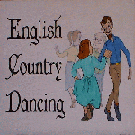User Tools
Sidebar
Pall-Mall
John Playford, 1686 Playford's
Interpreted by Andrew Shaw
Longways, duple minor
Tune: Pall-Mall
A1 1-4 1st man cast down below 2nd man to stand on the centre line facing up, as 1st
wo. goes down between 2nd cpl. and back up behind 2nd wo. to stand on the
centre line facing down, in diamond formation.
5-8 All go forward to meet and turn S. R. back out.
A2 1-4 2nd cpl. back-to-back R.
5-8 1st man and 2nd wo., 1st wo. and 2nd man, R-hand turn once round.
B1 1-4 1st cpl. R-hand turn once and a quarter round into 2nd place proper, as 2nd
cpl. fall straight back, then move up on the slant into 1st place.
5-8 Ist cpl. lead up through 2nd cpl. and cast back down, as 2nd cpl. cast down
and cross back up.
B2 1-4 1st cpl. half figure 8 up through 2nd cpl., as 2nd cpl. cast down and
lead back up. All improper.
5-8 Ptns. 2-hand turn once and a half round.
Video: https://www.youtube.com/watch?v=GNYT4HCG_bQ&t=91s
Note on the title:
Whether referring to PaH-MaH, the street in St. James's, London, or to the old game paH-maH
{pronounced pel'-mel' or pal'-mal'), the etymology is the same. Deriving from the Italian pallamaglio,
where paoa = ball and maglio = hammer, paH-maII was a game in which a boxwood ball was driven
with a mallet through an iron ring suspended above ground. It also referred to the long alley where
the game was played, and in 1661 Charles II had a new pall-mall laid out by the north wall of St.
James's Park. It was there that, in April of' that year, Samuel Pepys saw “the Duke of York playing at
Pelemele, the first time that ever I saw the sport” and where, in 1663, in conversation with the park-
keeper, he learnt of the practice of covering the surface of the alley with crushed cockle-shells.
Charles II's prowess, presumably honed during his exile in France, where the game was known as
PaiHe MaiHe, is extolled in Edmund Waller's 1661 work entitled A poem on St. James's Park: as lately
improved by His Majesty: “Here, a well-polished Mall gives us the joy/To see our Prince his matchless
force employ; …/No sooner has he touch'd the flying ball,/But 'tis already more than half the
MaH;/And such a fury from his arm has got,/As from a smoking culv'rin it were shot”.
It was this mall, repaired in the 1680s, which gave its name to the road beside it. By this time, Pall-
MaH had become part of Henry Jermyn, the Earl of St. Albans' exclusive development of St. James's
Square, London home of the aristocracy and foreign ambassadors.


